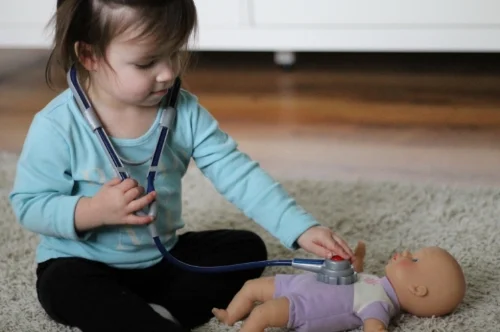“I don’t feel good.” “My tummy hurts.” “My head hurts.” If you are a parent, these are all too familiar words. However, if your child has a language delay, language disorder or autism, these may be words you wish to hear, as it can be very difficult for our kids to express how they are feeling when they feel “good” and even more difficult when they “don’t feel good”. Today we want to share a few ideas for when your child feels “good” to help them when they “don’t feel good.”
1. Body Parts: Teaching children their body parts is one of the first things to do when helping them try to explain “what hurts?” We like to teach body parts in a fun natural way throughout our day such as: playing Mr. Potato Head, playing with baby dolls (especially giving them a bath and dressing them) and through music (Head Shoulders Knees and Toes; Simon Says and more). For more detailed information on fun ways to teach body parts check out our old blog on Teaching Body Parts at www.kidspeakdallas.com
2. Doctor Books and Sick Books: Another thing we like to do is to read doctor and sick books to our children. Reading these books is going to help give them doctor and sick vocabulary words as well as give them visuals to see what it looks likes and what happens. Here are a few books we love: Doctor Maisy by Lucy Cousins; Biscuit Visits the Doctor by Alyssa Capucilli; and Corduroy Goes to the Doctor by Don Freeman.
3. Play Pretend Doctor: One of the best things you can do to help your child express themselves when they don’t feel well is to play pretend doctor.
First, you will need to help your child “get familiar” with the objects in the pretend set. Take out all the pieces and place them in your lap. Then one at a time take out a piece – you play with it appropriately – and then give it your child and help them do the same. For example, take out the stethoscope, place it in your ears and listen to a baby doll’s heart and say, “thump thump” – next hand it to your child and help them do this same routine.
Second, allow them to play alone with the play set. Give them the set and let them play. This will give them the chance to use all the skills you have worked on and see if they can increase their play skills without you.
Next, it is time to introduce “mini role” plays. Just like when you were working on getting familiar with the objects, you want to act out the mini role-play first and then let your child act it out. Here are a few examples: the baby can have a cough and need to see the doctor; the dog can have a tummy ache and need to see the doctor and more.
At our office we like to develop a routine such as, “Oh no! The baby is sick. Cough, cough. Time to see Dr. Amanda.” To help develop the routine you can use visuals and/or songs.
Once they have the routine down, focus on adding to it or changing it up. At this time we like to add in different body parts and focus on the “patient” saying “I don’t feel good. My XXX hurts.”
Fourth, once you have given them a few different “mini roles,” let them play alone and explore their own play.
Last, it’s time to role-play with people (adults and kids). Take turns being the doctor role and the patient role.
If you are able to work on these skill and activities when your child does feel well, then when your child actually does not feel well, they will have all of the vocabulary and skills needed to try their hardest to explain how they feel. In addition, if you used visuals during your pretend play activities, get these out and see if they can use them to tell you how they feel.
A sick child is one of the most stressful and difficult situations for a parent. Practice these fun activities when you can and give your child the language and skills they need to make things as easy as possible during the not so fun sick times!
~KidSpeak, LLC





